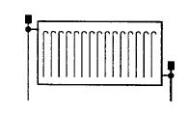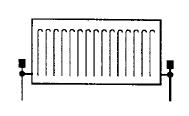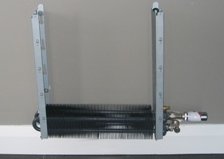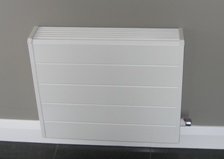Radiators - For Fast Home Heating
Heat emitters such as hot water radiators (Rad's) are the most common form of heat emitters associated with hydronic central heating systems. The most commonly used is the steel panel of which there are two types - the single panel, and the double panel.
For the different types of heat emitters see Hot Water Rads
This page contains sections on:
Are They Hot To Touch?
Yes they can sometimes feel hot to the touch - don't worry, low surface temperature models are available. Click here
Normally the surface temperature is around 75 to 80°C, although it rarely happens this could cause a problem for the young and the elderly who may not be able to react quickly enough if they come into contact with them.
Generally the heat output given by the manufacturer is higher than what is achieved in practice. This is because it is assumed that the standard valve connections is going to be 'Top and Bottom Opposite End' (TBOE), and that the 'mean' temperature difference between the water in the radiator and the air in the room will be 60°C.
Radiators release more heat (80% convective & 20% radiant) when the temperature difference between the 'air' in the room and the water in the emitter is greater - further apart, and less heat when the two temperatures are closer to each other.
In the UK the common practice for the flow and return pipe valve connections is the 'Bottom Opposite End' (BOE) configuration and a 55°C 'mean' temperature difference. This arrangement will reduce the manufacturers listed heat output by 12%.
The pictures below illustrates the TBOE and BOE pipe connections.
 Top & Bottom opposite end
Top & Bottom opposite end Bottom opposite end
Bottom opposite endWhat Are The Valves For?
There are three types of valves, and they are, a handwheel valve, a lockshield valve and a 'air' bleed valve.
The handwheel valve allows you the user to control the heat from any individual heat emitter at any time. Turning this valve fully clockwise will close it, and turning it an anti-clockwise direction will open the valve.
Even though there is a handwheel valve for individual control and a lockshield valve for balancing, both the handwheel valve (sometimes a Wheelhead valve) and the lockshield valve have the same action - they both open or close off the water flow through the valve.
The difference with the lockshield valve is it is used to set and control the water's 'flow rate' through the valve. Once the right flow rate is achieved the valve is then locked-off with a locking nut preventing you the user from being able to freely turn the valve and thereby unbalancing the system.
Some lockshield valves are designed to be locked with a special key
Handwheel and lockshield valves are bi-directional flow valves, i.e, water can flow in either direction through the valve which means that they can be fitted at either end regardless of the direction of water flow.
If the handwheel valve is to be replaced with a thermostatic radiator valve (TRV), be aware that the TRV is a uni-flow valve with only one direction for water flow. These valves are marked with arrows to indicate the direction of flow and must be fitted accordingly.
The bleed valve is usually fitted at one of the top corners of the heat emitter to enable the removal of air and also to facilitate the air removal from the heating system when it's first commissioned (filled with water).
If you have to periodically bleed air from a radiator in an existing system, it's an indication of a problem within the heating system.
What Does Balancing The System Mean?
Balancing the system simply means controlling the flow of heated water through each heat emitter to ensure that each emitter on the heating circuit receives ample amount of heated water to heat their area.
The lockshield valve controls the amount of water that flows through it once set. Typically the radiators that are first connected to heating circuit will want to steal most of the heated water which means that those at the end of the circuit are slow to heat up, or worse - fail to heat up at all.
This is overcome by having the lockshield valves in a nearly 'closed' position on the radiators at the beginning of the heating circuit, and 'fully' open on those at the end of the heating circuit. Once the system has been fully balanced all emitters will fully heat up.
What Are Low-Water Content Rads?
Low-water content radiators unlike the sectional panel or column types don't have sections or columns that are filled completely with heated water so making them not hot to touch.
With the low- water content type the heat exchanger is a looped tube, i.e, an elongated 'U' shaped pipe that is covered with a number of heat diffusion plates (fins) to increase heat output. Valves for these type of heat exchangers are typically fitted 'Bottom Same End' as the inlet and outlet connections (flow & return) are located close to each other at one end of the heat exchanger.
The advantage of low-water content heat exchangers are:
- Reduced water content in the heating circuit - spend less money to heat up
- Outer casing not in contact with the heat exchanger - meaning low surface temperature
- Not hot to touch - perfectly safe for the young and elderly
- Hidden tails pipes - no unsightly pipework
Below is a picture of a low-water content radiator.
 Low H2O radiator without casing
Low H2O radiator without casing Low H2O radiator with casing
Low H2O radiator with casingSee also:
Click here to visit online store.
Home Heat Loss Heat Gain Radiant Heat Central Heating Radiators UFH
Heat Pumps GSHP's WSHP's ASHP's Solar Heating PV Systems Boilers
Water Heaters Insulation Elec-Heaters
Terms of Use | Privacy | Contact Us

|
Visitors Say
Hi, My name is Shannon and I'm one of home-heating-systems-and-solutions.com readers. I'd like to thank you for the excellent information I've found on home-heating-systems-and-solutions.com, it's one of my favorite readings on the net. Warmest Regards Shannon United States
Thanks for the advice for removing an air lock from an indirect system. Had to change an inlet on my cistern. First time I have tried any home plumbing. After draining the cold tank system air locked when I refilled the tank. Garden hose and mains pressure up the tap sorted my problems. Would not have known what to do without the advice on the site. Many thanks Sean United Kingdom.
An excellent site. I have found it very usefull. I am currently in the design phase of a new house and have be pondering which heat system to use. From your site I have been able to choose the right system. Ross New Zealand
I enjoyed your site. Pat United States
We're so excited to announce our first Children Book
The Special and Talented Dog Show
To order click here
The second book published is called
Flying Things
This is aimed at a pre-school audience and is a rhyming story. You can buy by clicking here
To read more about our children's books, click here



